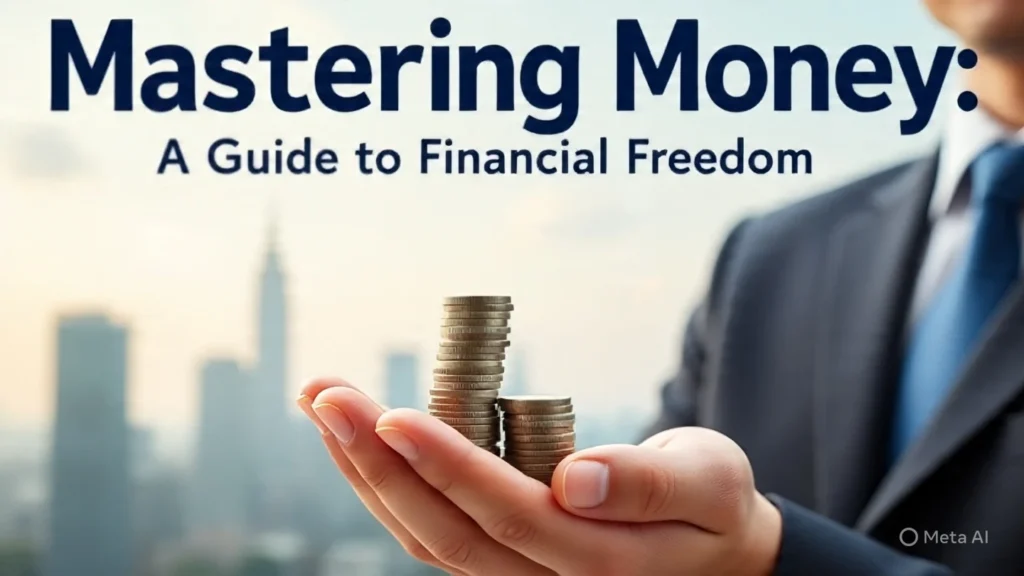Introduction to Financial Freedom
Financial freedom ka matlab hota hai ki aapke paas itna paisa ho ki aap apni life apne terms par jee sakein—bina financial stress ke. Ye sirf ameer banne ki baat nahi hai, balki apne paison par control paane ki baat hai. Jab aapke decisions paison ke darr se influenced na ho, tab aap truly financially free kehlate hain.
Chahe aap ek boring job chhodna chahein, duniya ghoomna chahein ya sirf apne monthly bills ke stress ke bina jeena chahein — financial freedom aapko ye sab karne ki azaadi deta hai.
Iss guide me aapko practical steps, mindset shift aur wealth building techniques ke baare me detail me bataya gaya hai jo aapko financial freedom ki journey me madad karenge.

Chapter 1: Understanding Your Money Mindset
The Psychology of Money
Aap paiso ke baare me kya sochte hain, woh aapke har financial decision ko impact karta hai. Bachpan me suni kuch baatein jaise “paise se sab kuch nahi hota” ya “main kabhi ameer nahi ban sakta” — yeh beliefs aapko success se door rakh sakti hain.
✅ Identify Your Money Story
Sochiye aapka upbringing paison ko lekar kaisa tha? Kya aapke ghar me paisa hamesha kam padta tha? Kya saving important samjha jata tha? Apni purani yaadon ko likhiye jisme paisa center me tha — usse aap apna pattern samajh payenge.
✅ Challenge Limiting Beliefs
Agar aapko lagta hai “main paiso me weak hoon,” to isse replace kijiye: “main apne paiso ko smartly manage karna seekh raha hoon.”
✅ Adopt an Abundance Mindset
Yeh maaniye ki duniya me paisa kamaane aur save karne ke kai tarike hain. Jab aap positive sochte hain, tabhi aapke actions bhi strong hote hain.
Setting Financial Goals
Bina clear goals ke aap life me drift karte rahenge. Financial goals aapko ek direction dete hain.
✅ Define Your Vision
Aapke liye financial freedom ka kya matlab hai? Early retirement? Apna ghar kharidna? Business shuru karna? Apna goal clear karein.
✅ Use SMART Goals
Goal hona chahiye: Specific, Measurable, Achievable, Relevant, aur Time-bound.
Example: “Main agle 2 saal me ₹8 lakh emergency fund ke liye save karunga.”
✅ Break Into Milestones
Bada goal ko chhoti steps me divide karein. Agar aapko ₹8 lakh save karna hai 2 saal me, to har mahine ₹33,000 save karna hoga.
✅ Write Them Down
Likha hua goal aapko motivation deta hai. Har din apne goal ko yaad dilaiye.
Chapter 2: Assessing Your Financial Situation
Creating a Financial Snapshot
Sabse pehle aapko ye pata hona chahiye ki aap abhi kis financial position me ho.
✅ Track Your Income
Har source of income likhiye — salary, side hustle, investments sab kuch.
✅ Monitor Your Expenses
Kam se kam ek mahine ka pura kharcha note karein. Zaroori (like rent, bills) aur non-zaroori (like coffee, OTT) me divide karein.
✅ Calculate Net Worth
Assets (bank balance, property, gold) – Liabilities (loan, credit card dues) = Net Worth
✅ Analyze Cash Flow
Aapki income aapke expenses se zyada honi chahiye. Agar aap jyada kharch kar rahe hain, to wealth banana mushkil ho jayega.
Budgeting for Success
Budget banana ek strong tool hai jo aapke goals tak le jaata hai.
✅ 50/30/20 Rule
50% needs ke liye, 30% wants ke liye, 20% savings/debt repayment ke liye.
✅ Zero-Based Budget
Har ek paisa ko koi na koi kaam do — isse kuch bhi waste nahi hoga.
✅ Envelope System
Cash me kharcha karna — har category (grocery, entertainment) ke liye ek envelope. Jab paisa khatam, spending bhi band.
💡 Pro Tip: Automatic savings aur bill payments setup karein — discipline banaye rakhna asaan ho jata hai.
Chapter 3: Eliminating Debt
The Burden of Debt
Debt financial freedom ke raste ka bada blocker hai — especially high-interest credit card debt. Aap jitna jaldi isse niptayenge, utni jaldi aap financially free banenge.
Strategies for Debt Repayment
✅ Debt Snowball
Chhoti se badi loan list banaiye. Sabse chhoti loan pe zyada payment karke usse finish karein, fir agle pe focus karein.
✅ Debt Avalanche
Sabse zyada interest wali loan pe focus karein. Isse aap long-term me paisa bachayenge.
✅ Debt Consolidation
Multiple loans ko ek single loan me combine karke, lower interest ke sath repay karein.
✅ Negotiate with Creditors
Banks ya lenders se negotiate karein — lower interest ya better EMI plan ke liye.
Avoiding New Debt
✅ Emergency Fund Banaiye
₹50,000–₹1,00,000 ka emergency fund aapko credit card lene se bachayega.
✅ Live Below Your Means
Apne lifestyle ko income ke hisaab se rakhein — overspending avoid karein.
✅ Use Credit Wisely
Credit card ka bill hamesha full pay karein. Interest lagne mat dein.
Chapter 4: Building an Emergency Fund
Why You Need an Emergency Fund
Emergency fund ek aisa financial safety net hota hai jo aapko unexpected situations—jaise medical emergencies, job loss, ya car repair—mein support karta hai. Agar aapke paas emergency fund nahi hai, to aapko debt lena pad sakta hai, jo aapke financial progress ko peeche le ja sakta hai.
Emergency fund se aap financially secure feel karte hain aur bina kisi stress ke situations handle kar paate hain.
How to Build an Emergency Fund
✅ Set a Goal
Shuruat me ₹50,000 ya ₹1 lakh ka short-term goal rakhiye. Long-term me aim karein ki aapke paas 3–6 months ke expenses ka buffer ho.
✅ Open a Separate Account
Emergency fund ko apne regular savings se alag rakhiye. Best hoga agar aap ise kisi high-yield savings account me rakhein jahan thoda interest bhi mile.
✅ Save Consistently
Har mahine fixed amount ko emergency fund me transfer karna ek habit bana lijiye—chahe ₹1000 ho ya ₹10,000.
✅ Cut Unnecessary Expenses
Subscription services, frequent food deliveries, ya impulse shopping ko control karke aap extra paisa save kar sakte hain.
When to Use Your Emergency Fund
Emergency fund sirf real emergencies ke liye hota hai—jaise:
- Job chhod dena ya chhoot jaana
- Medical bills
- Home/Car ka urgent repair
Lekin vacation, shopping, ya latest gadgets ke liye ise use na karein. Discipline maintain karna bahut zaroori hai.
Chapter 5: Saving and Investing for Wealth
The Power of Compound Interest
Compound interest ek magic jaisa kaam karta hai. Jab aap apne paise se paisa kamaate hain, aur phir us kamaye hue paiso se aur paisa banta hai, to ye process compound interest kehlata hai. Jitni jaldi aap start karenge, utna zyada fayda milega.
Saving vs. Investing
✅ Saving
Short-term goals ke liye hoti hai jaise emergency fund, trip, ya kisi event ke liye paisa jama karna. High-yield savings account ya Fixed Deposits sahi choice hoti hai.
✅ Investing
Long-term wealth creation ke liye hoti hai. Aap stocks, mutual funds, bonds, ya real estate me invest karke apne future ke liye paisa bada sakte hain.
Investment Options
✅ Stock Market
- Individual Stocks: High risk, high reward. Research karke invest karein.
- Index Funds/ETFs: Low cost, diversified option—S&P 500 jaisa fund beginners ke liye perfect hai.
- Bonds: Kam risk, lekin regular income ke liye best.
- Real Estate: Rental properties ya REITs ke through passive income generate kiya ja sakta hai.
✅ Retirement Accounts
- 401(k): Employer-sponsored plan hai—tax benefits ke sath aata hai.
- IRA: Individual Retirement Account, jisme Traditional ya Roth dono types ka option hota hai.
✅ Alternative Investments
Cryptocurrency, P2P lending, ya commodities jaise gold bhi options hain—but risk high hota hai, isliye limited amount hi invest karein.
Diversification and Risk Management
✅ Diversify
Sab paisa ek hi asset class me na lagaayein—stocks, bonds, real estate me balance banayein.
✅ Rebalance Regularly
Har 6 mahine ya ek saal me portfolio review karein. Jahan need ho, wahan adjustment karein.
✅ Understand Risk Tolerance
Agar aap young hain, to zyada risk le sakte hain. Lekin retirement ke kareeb ho to safe options prefer karein.
Chapter 6: Increasing Your Income
Why Income Matters
Agar aapki income badhti hai, to aap faster savings, investments aur debt repayment kar paate hain. Financial freedom jaldi achieve hoti hai jab aapki income streams strong hoti hain.
Strategies to Boost Income
✅ Advance Your Career
- Upskill: New skills ya certifications leke promotions ke liye qualify karein.
- Negotiate Salary: Market research karke confidently raise ke liye baat karein.
✅ Start a Side Hustle
- Freelancing: Content writing, graphic design, digital marketing jaisi skills monetize karein.
- Hobby Monetize: Handmade products, photography ya online teaching start karein.
- Gig Economy Jobs: Zomato, Swiggy, Uber, ya freelancing platforms pr kaam karein.
✅ Create Passive Income
- Dividend Stocks / REITs: Long-term ke liye monthly/quarterly income milti hai.
- Digital Products: eBooks, online courses, templates, etc.
- Property Rental: Agar spare room ya flat hai, to Airbnb jaisa platform use karein.
Scaling Your Income
Ek baar income stream start ho jaaye, to usse scale karne ka sochiye—freelance gig ko full-time business me badalna ya side hustle ka paisa invest karke aur income generate karna.
Chapter 7: Planning for Retirement
The Importance of Retirement Planning
Retirement ke baad bhi ek stable income source chahiye hota hai—aur yeh tabhi possible hai jab aap aaj planning shuru karein. Jitni jaldi start karenge, utna hi kam aapko monthly save karna padega, thanks to compound growth.
Steps to Plan for Retirement
✅ Estimate Your Needs
Apne retirement ke baad ke expenses ka idea lagaayein—typically 70–80% of your current income is enough.
✅ Maximize Retirement Accounts
- 401(k): Employer ka match lena mat bhooliye—ye free paisa hai!
- IRA: Roth ya Traditional IRA me annual limit tak invest karein.
✅ Social Security & Healthcare
- Benefits ka estimate Social Security website se nikaliye.
- Retirement ke baad ka healthcare cost bhi plan me include karein—Medicare bhi cover nahi karta sab kuch.
FIRE Movement (Financial Independence, Retire Early)
✅ Calculate FIRE Number:
Annual expenses × 25 = FIRE number. Example: ₹12 lakh annual expenses × 25 = ₹3 crore.
✅ Invest Aggressively:
Index funds, mutual funds, ya rental real estate—jitna zyada invest karenge, utna fast freedom milega.
✅ Live Frugally:
Low-cost lifestyle maintain karke savings rate 50–70% tak le aayein.
Chapter 8: Protecting Your Wealth
Insurance
Jab aapne apni wealth build kar li hai, to usse protect karna bhi utna hi important ho jaata hai. Insurance ek shield ki tarah kaam karta hai jo unexpected financial losses se aapko bachata hai.
✅ Health Insurance
Aaj ke time me medical treatment bahut mehenga ho gaya hai. Agar aapke paas proper health insurance nahi hai, to ek bada bill aapke saari savings khatam kar sakta hai.
✅ Life Insurance
Agar aap par kisi ka financial depend hai (jaise spouse ya children), to life insurance lena bahut zaroori hai. Term life insurance affordable aur sufficient hota hai.
✅ Disability Insurance
Agar kisi illness ya injury ki wajah se aap kaam nahi kar sakte, to ye insurance aapki income ka replacement deta hai.
✅ Homeowners / Renters Insurance
Fire, theft, ya natural disaster jaise situations me aapke ghar aur saman ki protection ke liye ye insurance zaroori hai.
Estate Planning
Estate planning se aap ensure karte hain ki aapke assets aapki marzi ke mutabik distribute ho, bina kisi legal complications ke.
✅ Create a Will
Ek legal document jisme likha hota hai ki aapke marne ke baad aapki property kaise distribute hogi.
✅ Designate Beneficiaries
Bank accounts, mutual funds, insurance policies me nominee set karna mat bhooliye.
✅ Consider a Trust
Agar aapki property value high hai, ya aap taxes minimize karna chahte hain, to ek trust banwana ek smart step ho sakta hai.
Avoiding Scams
Aaj ke digital era me frauds aur scams kaafi common ho gaye hain. Apne wealth ko safe rakhne ke liye:
✅ Verify Investments
Jo bhi investment opportunity mile, use properly research karein. “Get-rich-quick” schemes se door rahna hi safe rahta hai.
✅ Secure Your Data
Strong passwords aur 2-factor authentication ka use karein. Public Wi-Fi par banking ka use avoid karein.
✅ Consult Professionals
Big financial decisions lene se pehle certified financial advisor ya CA se consult karna hamesha better hota hai.
Chapter 9: Staying Disciplined and Motivated
Building Financial Habits
Wealth build karna ek marathon hai, sprint nahi. Is journey me discipline aur consistency sabse important role play karte hain.
✅ Review Finances Regularly
Har mahine apna budget, investments aur progress check karein. Dekhiye ki aap apne financial goals ke kitne kareeb hain.
✅ Automate Everything
Savings, bill payments aur investments ko automate karne se aap forget nahi karte aur financial discipline bana rehta hai.
✅ Educate Yourself
Naye financial books padhiye, podcasts suniye ya YouTube channels follow karke financial literacy badhaiye.
Suggested books:
- The Millionaire Next Door
- Your Money or Your Life
Overcoming Setbacks
Life me hamesha sab kuch plan ke hisaab se nahi hota. Job loss, medical emergency, ya market crash kabhi bhi ho sakta hai.
✅ Reassess and Adjust
Agar koi setback aaye to panic na karein. Budget ko dubara banayein, unnecessary expenses cut karein, aur new plan banayein.
✅ Stay Positive
Apne chhote achievements ko yaad rakhein. Har setback se kuch seekh kar aage badhna important hota hai.
✅ Seek Support
Online financial communities join karein ya kisi financial coach ke sath kaam karein jisse aapko guidance aur motivation mile.
Celebrating Milestones
Goal achieve hone par celebrate karna bhi zaroori hota hai. Jaise:
- Credit card debt clear hua? 🎉
- ₹1 lakh ka saving complete hua? 👏
Ek chhoti si celebration aapko aur motivate karegi.
Chapter 10: Living a Financially Free Life
Defining Your Freedom
Financial freedom har kisi ke liye alag hota hai. Kisi ke liye matlab hai full-time job chhodkar apna passion follow karna, to kisi ke liye retirement aur world tour.
Apne goals aur values ke saath regularly reconnect karte rahiye. Check kariye ki aap jo plan bana rahe hain, wo aapke sapno ke life ke saath align kar raha hai ya nahi.
Giving Back
Jab aap financially stable ho jaate hain, to aap dusron ki madad bhi kar sakte hain. Kuch examples:
- Apne community me kisi student ka mentorship dena
- Financial literacy workshop organize karna
- Social impact investments me paisa lagana
- Charity ya NGO ke projects me donate karna (voluntarily)
Continuous Improvement
Finance ki duniya me har waqt changes hote rehte hain—tax rules, investment returns, inflation, etc.
✅ Regular news padhte rahiye
✅ New saving/investment tools explore karte rahiye
✅ Apne financial plan ko saal me ek baar update karna habit banaiye
Conclusion
Mastering money ka matlab sirf paisa kamaana nahi, balki paiso par control paakar apni zindagi ko apne rules par jeena hota hai. Jab aap apne money mindset ko sudhaar karte hain, clear financial goals set karte hain, debt se chutkaara paate hain, aur responsibly invest karte hain—to aap gradually financial freedom ki taraf badh jaate hain.
Ye journey patience, discipline aur continuous learning maangti hai. Lekin jo reward milega—bina financial stress wali life—uske saamne ye mehnat kuch bhi nahi.
🟢 Aaj se shuruaat kijiye. Chahe ek simple budget banana ho ya ₹500 savings account me dalna ho—ek chhoti si action aapko apne sapne ke aur kareeb le jaayegi.
Your financially free future is just a step away.
✅ FAQs – Financial Freedom Hinglish Blog
❓What is financial freedom?
Answer:
Financial freedom ka matlab hota hai paiso ke stress ke bina jeena. Jab aapke paas itna wealth hota hai ki aap apne choices khud le sakein—bina loan ya bill ke darr ke—that’s called true financial freedom.
❓Main financial freedom kaise achieve kar sakta hoon?
Answer:
Iske liye aapko apna money mindset change karna hoga, clear goals set karne honge, debt eliminate karna hoga, smart savings aur investments karne honge. Ye sab consistent habit aur patience se possible hai.
❓Emergency fund kitna hona chahiye?
Answer:
Aapke monthly expenses ke 3 se 6 mahine ka fund emergency fund ke roop me hona chahiye. Agar aap beginner hain to ₹50,000–₹1,00,000 se start karein.
❓FIRE movement kya hota hai?
Answer:
FIRE ka full form hai Financial Independence, Retire Early. Ye ek movement hai jisme log aggressively save karte hain (50–70% income) aur early retirement ke liye invest karte hain, taaki wo 40 ke age ke aas paas financially free ho jayein.
❓Main low salary me bhi wealth kaise build kar sakta hoon?
Answer:
Bilkul kar sakte hain! Apne expenses control karke, side hustle shuru karke, aur smartly invest karke aap gradually wealth build kar sakte hain—even with a low income.
❓Mujhe investment start karne ke liye kya chahiye?
Answer:
Aapko basic documents chahiye honge—PAN card, Aadhaar card, aur ek savings bank account. Uske baad aap mutual funds, stocks, ya digital gold me invest kar sakte hain via apps jaise Zerodha, Groww ya Paytm Money.
❓Financial planning me kaunse books helpful hain?
Answer:
Kuch popular aur helpful financial books:
- The Psychology of Money – Morgan Housel
- Rich Dad Poor Dad – Robert Kiyosaki
- The Millionaire Next Door – Thomas Stanley
- Your Money or Your Life – Vicki Robin
❓Passive income kya hota hai?
Answer:
Passive income ka matlab hota hai wo income jo aapko bina active work ke regularly milti hai. Jaise rent, dividend, eBook sales, ya YouTube monetization.



